OSCAR meets expectations
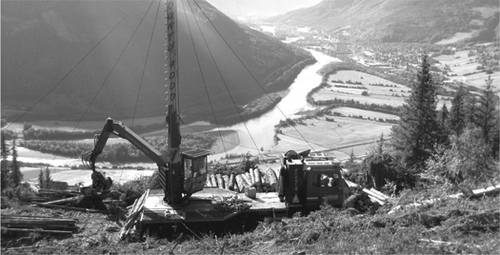 Cable-yarding in steep terrain is an example of the variable conditions for harvesting operations in the Nordic countries. The OSCAR conference took a narrow look at the method. Of special interest were the full scale Konrad ‘Mounty’ 4000’ yarder-processor, operated by Frivik Taubanedrift AS, and the new 1:3 scale Owren mini 400 yarder, which was built in Norway for training and recruitment purposes. Photo: Bruce Talbot
Cable-yarding in steep terrain is an example of the variable conditions for harvesting operations in the Nordic countries. The OSCAR conference took a narrow look at the method. Of special interest were the full scale Konrad ‘Mounty’ 4000’ yarder-processor, operated by Frivik Taubanedrift AS, and the new 1:3 scale Owren mini 400 yarder, which was built in Norway for training and recruitment purposes. Photo: Bruce Talbot
At the third OSCAR conference, coordinator Magnus Thor summed up the activities: most of the expectations had been met, and many had been exceeded.
The SNS-supported network activity OSCAR (Operations Systems – Centre of Advanced Research) is reaching the end of a five-year period in the current format.
The concluding conference took place in Norway in October, and was hosted by the Norwegian Forest and Landscape Institute (Skog og landskap). More than 70 researchers from the Nordic and Baltic countries travelled to the Honne conference centre, south of Lillehammer.
Flash presentations
Two rather unusual approaches were used in the conference, which consisted of 12 sessions and 57 presentations.
First, there were no themes for the sessions and the audience was exposed to a wide range of challenges, methodologies and discussions. The idea was that "the forest operations family is small enough without further fragmentation”.
Secondly, one session was allocated to ‘flash presentations’, a concept borrowed from EU partnering events in which presenters have 6–8 minutes to inform the audience briefly of the aim, content and results of their project – an exercise which received a lot of positive feedback.
The network has a future
In his closing address on the third day, OSCAR coordinator Magnus Thor (Skogforsk, Sweden) summed up the past five years of OSCAR activity. He suggested that most of the expectations of the CAR had been met, and many had been exceeded. OSCAR has held three large conferences, precipitating many smaller projects and networks of cooperation, the results of which are difficult to quantify, but nonetheless important in building on the very long tradition of interaction between researchers in this field.
At the business meeting held during the conference, the coordination committee selected Latvia (SILAVA) as the host country for the 2012 conference, despite present uncertainty about the future of the CAR.
Proceedings are available as a pdf via the OSCAR website:
http://www.skogforsk.se/sv/Om-oss/Samverkan/Oscar/
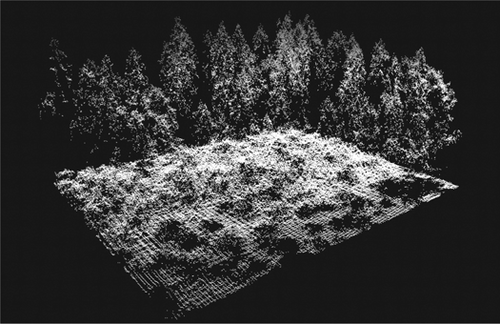
Picture of a forest made with laser scanning.
Courtesy: Terje Gobakken and Svein Sohlberg,
Norwegian University of Life Sciences
Laser scanning – where the Nordic countries have taken a lead
In the last issue of News & Views, we announced the Jubilee Award presented to Professor Erik Naesset, Norwegian University of Life Sciences, for being the most cited author. Professor Naesset is a leading authority in the field of forest inventory and forest characterization with airborne laser scanning. We were curious to learn more about the technique, and asked him some questions: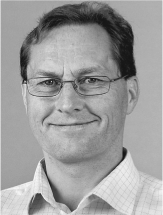
Professor Erik Naesset
The use of laser scanning in forest management inventory seems to be lead by the Nordic countries. Why?
Forest management inventory has been a research field that has received much attention in the Nordic forest faculties over the last 30 years – irrespective of technology, so it was natural to look into the use of lasers when the technology became available at a practical scale in the mid 1990s. Finland, Norway and Sweden started making use of the technology very early, even in an international context. The first scientific papers on airborne laser scanning in forest research were published by Nordic scientists (1997).
Links between research institutions, forest companies and public administration have always been close in the Nordic countries. So, the distance from research to practice has been short.
Another explanation is the way large surveys are organized, especially in Norway and Finland, has been of great benefit. Mapping and surveying authorities as well as the forestry sector have collaborated closely, resulting in fruitful coordination and cost-sharing of data acquisition with lasers.
What about small private forests?
Norway and the southern parts of Finland and Sweden have very fragmented forest ownership structures with small property sizes. It is natural to consider that these countries would be the LAST to bring the new technology into use because the main value is economies of scale: large areas have to be covered by each data acquisition to be economically competitive. However, in Norway as well as Finland, there are economic subsidies encouraging forest owners to collaborate and share costs. The public forestry authorities also help to organize joint inventories. Thus, a management inventory typically covers 50–2000 km2, which was the case even before lasers entered the market. Everything was actually well set up for the use of lasers.
In Sweden, there seem to be more challenges related to organizing the smaller forest properties. It has mainly been the large forest companies who have shown interest in forest inventory with lasers.
Is the method used operationally?
Yes, indeed! The first full-scale operational inventory (460 km2) conducted on pure commercial terms was carried out in 2002 in Norway and reported in an article in Scandinavian Journal of Forest Research (SJFR) two years later. Since then, it has grown rapidly. Finland started somewhat later, but commercial inventories have been carried out since at least 2007. Almost 100% of the inventories in both Norway and Finland are now produced using lasers.
Sweden started early, around 2005. Growth has been slow, but is expected to increase significantly. A national laser survey is currently taking place, and it will result in full coverage of the country over a four year period.
What is the situation outside the Nordic countries?
There are still many “piloting” activities and demonstrations going on around the world. Every country seems to undertake the same exercises as the Nordic countries. So far, inventories have been conducted operationally in Canada, the USA, Spain and Australia, at least. But there have been demonstrations at a fairly large scale in all the Baltic countries, Portugal, Switzerland, and Brazil. It also appears that operational activities are taking place in other countries in South America and in Japan.
What about the accuracy?
Results from all the Nordic countries point at that lasers are more accurate for estimating quantitative stand variables compared with conventional alternatives such as aerial photo interpretation supported by field work. Variables measured for management planning include timber volume, mean tree height, mean stem diameter, stem number, basal areal and tree size distribution. As an example, the error (accuracy – RMSE) of timber volume is typically 10% of the mean volume, which is around half the error experienced with other methods.
In some inventories, it has even been a focus on data for individual trees, such as individual tree positions and single-tree parameters.
Erroneous and incorrect information may lead to sub-optimal decisions and loss of money when using forest inventory data in management decisions, but this loss must be weighed against the costs of the inventory. One study (the one and only on this topic) published in SJFR in 2004 provided convincing evidence of higher economic revenues when data were produced by laser inventories.
Which are the future most important research questions in this field?
I see three distinct directions for future research – and we can already see evidence of these directions:
-
Further refinement and improvement of management inventories produced using lasers with more efficient use of field data and the extraction of more variables, including biodiversity, biological and silvicultural aspects.
-
More detailed use of the data with more focus on single-tree information, especially in conjunction with tactical planning, planning of harvests, timber sales, improved bucking and higher values of the wood resulting from improved information about timber qualities in the forest prior to harvesting.
-
Application to larger areas, such as counties, regions, provinces, states and even nations.
Riparian forest is an important ecosystem
Forests growing along streams, rivers and lakes (riparian forests) constitute 2% of the forest area in the Nordic countries (if we consider them as comprising a 10 m wide zone from the water body). Despite the small proportion of the area that they occupy, they are associated with important ecological functions.
In a new article in the journal Ambio, the environmental services related to water protection, terrestrial biodiversity, carbon storage and green-house gas dynamics provided by riparian forests in the Nordic countries are reviewed.
The authors conclude that forest buffers are effective in protecting water quality and aquatic life, and have positive effects on terrestrial diversity. The positive effects are particularly marked when the buffer is broader than 40 meters. The effect of buffer forests on greenhouse gas exchange is, however, unclear.
The report is an output of the SNS-supported CAR-ES network (Centre of advanced research on environmental services), with authors from Denmark, Finland, Sweden, Norway and Iceland.
Source: Gundersen, P. et al. 2010. Environmental services provided from riparian forests in the Nordic countries. Ambio, DOI 10.1007/213280-010-0073-9
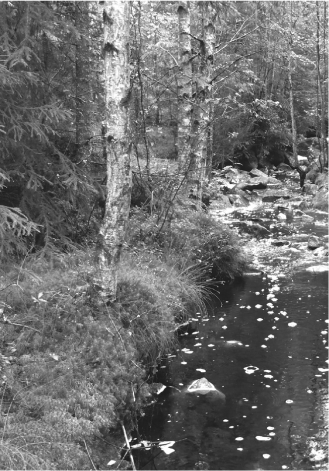
Riparian forest along a stream in central
Sweden. Photo: Mats Hannerz
New office for Forest & Landscape: Finally together
Wood provides the natural framework for Forest & Landscape Denmark in its new house at Frederiksberg, Copenhagen. The new building was inaugurated in September after a giant movement of almost 100 researchers and staff from the previous premises in Hørsholm, north of Copenhagen. Most of the centre's staff is now under one roof.
The new building is connected to the old university building, which already hosted three departments of Forest & Landscape Denmark, through a glass corridor at 1st floor. The visitor encounters wood in every aspect of the building. The outer surface is covered with thuja, which has its own natural preservatives. The indoor flooring is vivid strip oak contrasting with the light ash wall panels. The ash wood inlay has a profile developed not only for decoration, but also to reduce noise. Birch is used as the wall covering in the auditorium, thereby strengthening the impression of the Nordic light in the building. Danish design is also highlighted in the furniture, provided by sponsors.
Katrine Hahn Kristensen has been leading the task to get the researchers and staff in place, and also to create an integrated organization in which previously disparate groups cooperate under one roof.
– It has been a challenging but also rewarding process for the whole organization to merge physically, now almost six years after the institutional merger, she says.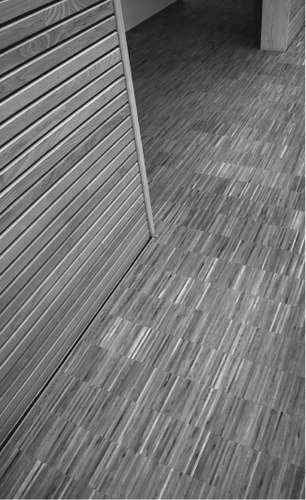
Oak meets ash. Local trees and beauty.
Photo: Mats Hannerz
Facts about Forest & Landscape
In total, 350 persons work at Forest & Landscape Denmark, which is a national centre at the Faculty of Life Sciences, Copenhagen University. The Centre was established in 2004 by merging the Danish Forest and Landscape Research Institute, the Danish Forestry College, the Danida Forest Seed Centre and parts of the Department of Economics and Natural Resources of the former KVL– the Royal Veterinary and Agricultural University of Denmark.
As a result of the move, Forest & Landscape Denmark has most of its staff on the Frederiksberg campus. The centre also includes The Forestry College in Nødebo, where about 60 people work.
Read more
www.sl.life.ku.dk
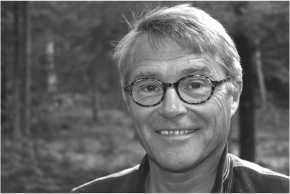
Dane leads EFI board
The European Forest Institute (EFI) has elected Professor Jørgen Bo Larsen from Denmark as the new chairman of its board. J. Bo Larsen replaces Professor Konstantin von Teuffel from Germany, who was the incumbent between 2006 and 2010.
EFI is the leading forest research network in Europe, supported by 125 member organizations from 37 countries. Liisa Saarenmaa from Finland continues as vice-chairman of the board, which consists of eight members.
Read more: www.efi.int